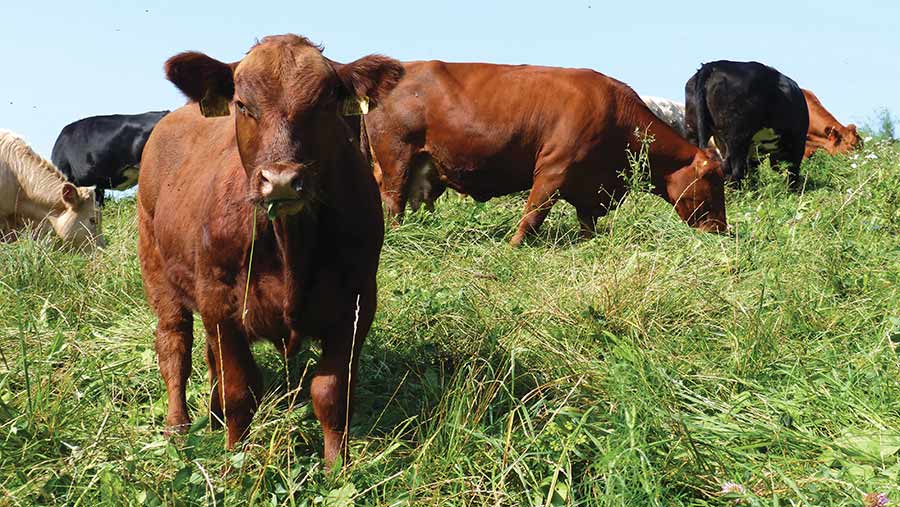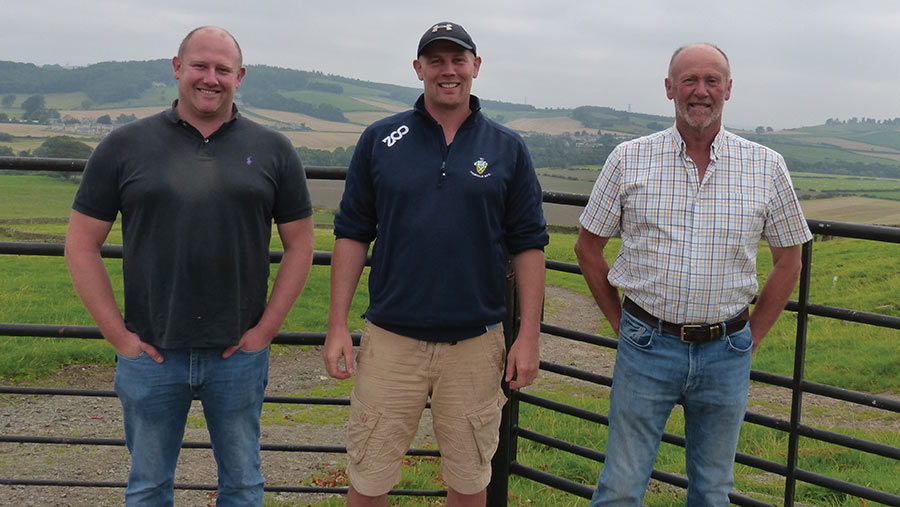Video: Soil health focus reduces cow variable costs by 40%
 © MAG/Michael Priestley
© MAG/Michael Priestley Basing a farming system on improving soil health has helped a Northumberland mixed farm strip costs out of its sucklers and halve its winter housing period.
The variable costs of running a cow for a year has fallen from £550-£600 to £300-£350 for the Johnsons of West Wharmley, near Hexham, since moving to forage-based genetics and mob grazing in a regenerative system.
Stuart Johnson, who farms with father Richard and brother James, says the aim across the beef, sheep and arable enterprises on their tenanted farm is now “margin over yield”.
See also: Organic mob grazing system cuts £380/livestock unit on estate
“We are producing individually lower yielding products, but we are more resilient and I think that’s a better place to be,” says Stuart. “We don’t worry so much about the price of inputs.”
A host of changes have been made since first experimenting with a strip till drill in 2012 and trying to work with nature and regenerative techniques.
This approach has won the Johnsons this year’s Soil Farmer of the Year award at Groundswell.
Watch the video showing how the Johnsons achieve seven plus years out of herbal leys and read the full report below.
West Wharmley farm facts

James, Stuart and Richard Johnson © MAG/Michael Priestley
- 400ha on tenancy and lets over three blocks
- Farmed at West Wharmley since 1874, supported by Messrs Straker on the Leazes Estate
- 75 Stabiliser cross suckler cows
- 110 heifers bought and bred and sold with calves at foot
- 800 Aberfield cross, Abertex and Primera breeding ewes in a self-replacing flock
Previous system
Proud stockmen and former show calf competitors, the Johnsons used to run a flying herd of 60 continental cross cows.
Calves by Charolais terminal sires were creep fed and wintered inside with the cows and sold in the spring as yearlings. They also calved 70 bought heifers a year and sold them with calves at foot.
The livestock, which included 800 North of England Mules and Texel Mules and some trading store cattle required 300t of homegrown grain annually on 60ha, with surplus sold.
Current system
Stabiliser bulls are used to breed replacements and easy calving Charolais terminal sires are used over the rest of the herd.
Feed, housing, and wintering costs are substantially lower, but calf values can also be 15-20% lower due to the change of breed, explains Stuart.
Calves are sold in the autumn at seven months old. Creep is still offered as buyers like to know calves have had their rumens adjusted to cereals.
Cows are now outwintered on permanent pasture deferred from August on daily moves with drag troughs and back fencing.
Deferred mob grazing costs less than 50p a cow a day compared to the housed period at £2 a cow a day, so keeping cows out as long as possible is now the aim.
This has shortened the housed period by three months. Cows are turned back outside after calving in March and April.
The system doesn’t require expensive reseeds or damage the land, says Stuart.
Over the past seven years the continental bred cows have mostly been culled out as many struggled to thrive in the forage-based, low input system.
They continue to run a calved heifer enterprise buying continental cross heifers and selling them with calves at foot.
Long rest periods
A key feature of the system is resting grass and herbal leys for 40 days or more before returning, giving roots time to grow fatter and deeper in the soil.
“We used to grow huge forage cover crops and winter cows on them, but that made an awful mess,” explains Stuart.
“We realised it’s roots in the ground, creating aggregates and improving water infiltration, that hold cattle up.”
But the Johnsons aren’t prescriptive about how fields are grazed.
Some fields are left for six-to-12 months, to help root development, allow plants to seed so swards can self-rejuvenate, and to be a “disruptive” influence, shocking plants, and interrupting cycles naturally, explains Stuart (see How to manage your farm for healthy soils).
This might seem wasteful, but the Johnsons have increased pasture acreage at the expense of arable ground because the farm only requires 120t of cereal a year.
“Last year we only grew 30ha of cereals and we didn’t need it,” explains Stuart.
“Our seven-year rotation is now five years of herbal leys building up a soil fertility “bank account” and two years utilising this fertility with low input arable.”
Other benefits
The sheep and arable units have also benefited from 11 years of learning about regenerative farming. This means:
- Fertiliser use is less than 10t a year. Previously, the farm bought 70-90t of fertiliser annually. No fertiliser is now used on grassland
- A breakeven yield of less than 2.5t/ha on wheat and barley
- A reduction in cake use from 30t to 8t a year.

© MAG/Michael Priestley
How to manage your farm for healthy soils
The Johnsons have learned from many regenerative farmers, but close discussions with Gabe Brown and Allen Williams of Understanding Ag, have been crucial to development.
The six principles for soil health in Understanding Ag, are as follows:
1. Context: Know your environment
- The Johnsons’ “unfair advantage” is having light, gravelly, free-draining land by the side of the River Tyne in a moderate (650-700mm) rainfall area, which helped them experiment with outwintering, which now works on heavier soils, too.
- Having light land was what made them consider direct drilling, after a throwaway comment from a contractor suggested they “could get away without ploughing”.
2. Disturbance: Do not disturb the soil chemically or mechanically
- Seven years of a no-till drill after five years of a Claydon strip till drill means the Johnsons haven’t ploughed for more than 10 years.
- No fungicides, pesticides or insecticides are used on wheat and barley. This saves £148/ha. Instead, homemade compost teas, along with nutritional foliar and soil feeds that use fish and seaweeds to increase the fungal to bacterial ratio in the soil. This was learned from a local contractor and costs £2-3/ha per pass
- Sheep grazing winter cover crops has also helped minimise fertiliser use
3. Armour: Keep the soil covered
- Direct drilling, leaving a reasonable residual after mob grazing and deferring grass for several months means soil life is sheltered from the sun’s heat, while holding in moisture
4. Enhance diversity: Minimise monocultures
- Having sheep, sucklers, arable and the heifer-rearing enterprise involves varied grassland and soil management and provides several income streams.
- Herbal leys are selected to be varied, some containing 20 species, including deep-rooting grasses like cocksfoot, timothy and fescues, and herbs like fennel and yarrow. A range of rooting depths helps provide more habitats for life under the soil.
- Cereal monocultures are minimised to two years in a seven-year rotation, and usually grown undersown with clovers.
5. Living roots: Keep feeding microorganisms
- With direct drilling, the soil is not inverted, and root exudates are always feeding soil microbiology.
- Glyphosate use is reduced by controlling weeds using lower rates (1l/ha rather than 3l/ha by adding fulvic acid and reducing the pH to 2.8) and by strategic mob grazing to control weeds.
6. Livestock: Grazing is essential for soil health
- Soil testing has shown higher organic matter on the parts of the farm in the livestock rotation, consequently producing higher-yielding cereal crops